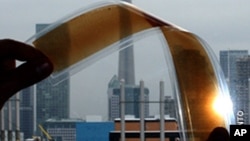Researchers in Canada have successfully tested a spray containing microscopic particles that one day could be used to make electricity for everything from mobile devices to homes.
The particles, known as CQDs [colloidal quantum dots] also are referred to as “artificial atoms.” They are highly efficient at absorbing light, including the part of the spectrum that is invisible to the human eye.
Sprayed into a film, CQDs make a lightweight, flexible solar cell that can be wrapped around large structures, including those with irregular surfaces. Researchers say the spraying process is very easy to perform.
The new technology could change how devices and possibly homes and commercial buildings are powered. A home with a roof wrapped in CQD film, for example, may generate all the electricity needed for daily use.
Although the first experiments have been successful, scientist anticipate the product will not be on the market for five to 10 years.
The research project is a collaborative effort led by the Sargent Group at the University of Toronto, with participation by IBM Ontario, the governments of Canada and the Canadian province of Ontario, and seven other universities.
The Sargent Group is a program of the university that connects chemistry, physics, and engineering within eight experimental laboratories.
The program is named after Ted Sargent, a professor at the University of Toronto, where he chairs the nanotechnology program.









